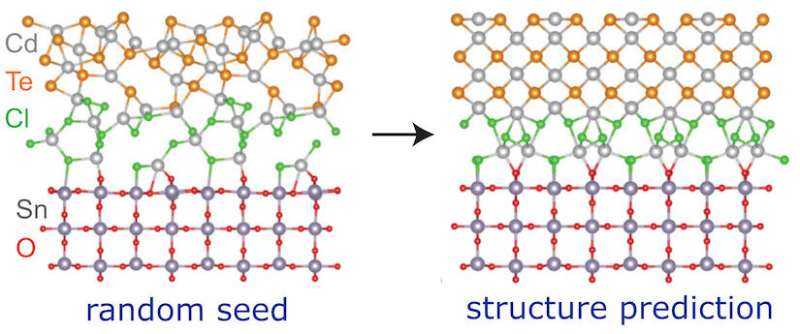Mechanism of long-used solar cell treatment explained by unexpected crystalline structure
For more than three decades, photovoltaic researchers have known that the addition of a single chemical—cadmium chloride—creates better-performing cadmium telluride (CdTe) solar cells. But they have not understood exactly why, until now. The answer has implications for materials science that stretch well beyond solar cells.
The light-absorbing layers in CdTe solar cells are composed of a thin film of material, about 10–100 times thinner than a human hair. Lots of modern devices, from solar cells to catalytic materials to organic light-emitting diode TVs, rely on thin-film materials. The surfaces at which these thin layers meet, or interfaces, are even thinner—100,000 times thinner than a human hair—and play a crucial role in the devices’ functions. A better understanding of thin-film interfaces could improve how we fabricate many different materials, but the precise structure of interfaces at the atomic scale is often difficult to study.
A proven, but unexplained, boost for solar cells
In CdTe solar cells, the electrical charges created by an absorbed photon can be trapped and lost at the interfaces between the light-absorbing layer and the layers that carry those charges away into electrical circuits. As early as the 1980s, CdTe researchers realized that treating the interfaces in the solar cell with a small amount of cadmium chloride (CdCl2) could reduce the loss of charges at the interfaces and improve the solar cell’s power conversion efficiency.
Clearly, the addition of CdCl2 changed the interface in a crucial way. But further experiments could not resolve the interface’s structure down to the atomic level to explain why the CdCl2 treatment was so effective. This challenge is not unique to CdTe solar cells. Interfaces are notoriously difficult to study and understand at the atomic level, especially in cases of nonideal interfaces between materials that have different crystal structures.

Modeling offers new insights into interfaces
A new approach from a team of National Renewable Energy Laboratory (NREL) researchers and colleagues at Khalifa University, Bowling Green State University, and First Solar—an American CdTe solar manufacturer—has unmasked the details of the CdCl2 interface treatment. By modeling the behavior of individual atoms and electrons, the team simulated possible arrangements for CdCl2-treated interfaces.
To calculate the electronic structure of a CdTe solar cell—and thereby determine its charge collection—the researchers first needed to determine the atomic arrangement CdCl2 interface, which had never before been done for CdTe solar cells. To achieve this, the team implemented a structure prediction algorithm for interfaces. The algorithm began with a random arrangement of atoms and then allowed them to settle, using a method called density functional theory to calculate the atomic forces. The algorithm repeatedly made small but realistic changes to the positions of the atoms at the interface, which allowed the team to identify the lowest-energy (most stable) structures.
The work is published in the journal Applied Physics Reviews.
More information:
Abhishek Sharan et al, Atomically thin interlayer phase from first principles enables defect-free incommensurate SnO2/CdTe interface, Applied Physics Reviews (2022). DOI: 10.1063/5.0104008
Citation:
Mechanism of long-used solar cell treatment explained by unexpected crystalline structure (2023, February 22)
retrieved 22 February 2023
from https://techxplore.com/news/2023-02-mechanism-long-used-solar-cell-treatment.html
This document is subject to copyright. Apart from any fair dealing for the purpose of private study or research, no
part may be reproduced without the written permission. The content is provided for information purposes only.
For all the latest Technology News Click Here
For the latest news and updates, follow us on Google News.
